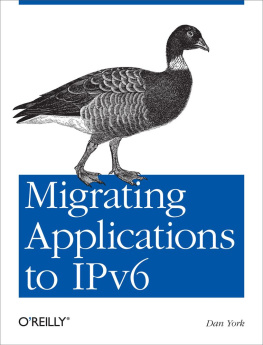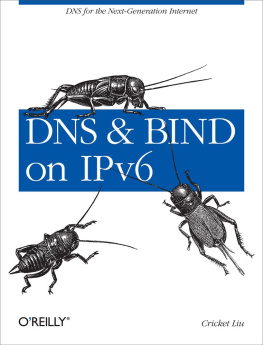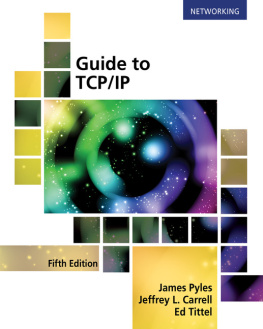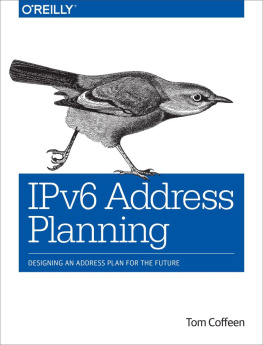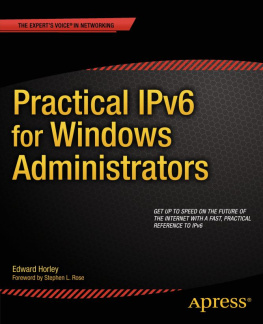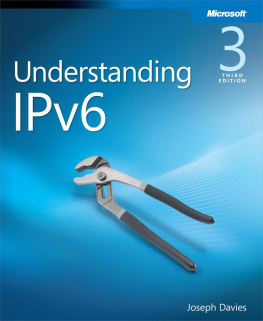Supplemental files and examples for this book can be found at http://examples.oreilly.com/9780596100582/. Please use a standard desktop web browser to access these files, as they may not be accessible from all ereader devices.
All code files or examples referenced in the book will be available online. For physical books that ship with an accompanying disc, whenever possible, weve posted all CD/DVD content. Note that while we provide as much of the media content as we are able via free download, we are sometimes limited by licensing restrictions. Please direct any questions or concerns to .
Preface
This book is about the next generation Internet protocol. We have become familiar with the strengths and weaknesses of IPv4; we know how to design and configure it, and we have learned how to troubleshoot it. And now we have to learn a new protocol? Start from scratch? Not really. The designers of IPv6 have learned a lot from over 15 years of experience with IPv4, and they have been working on the new protocol since the early 1990s. They retained the strengths of IPv4, extended the address space from 32 bits to 128 bits, and added functionality that is missing in IPv4. They developed transition mechanisms that make IPv4 and IPv6 coexist peacefully and that guarantee a smooth transition between the protocols. In fact, this was one of the major requirements for the development of the new protocol version.
So you do not need to forget what you know about IPv4; many things will feel familiar with IPv6. When you get started, you will discover new features and functionalities that will make your life a lot easier. IPv6 has features that you will need in tomorrow's networksfeatures that IPv4 does not provide. The day will come when our Personal Digital Assistants (PDAs) and mobile phones have IP addresses. Aside from the fact that the IPv4 address space could never cover the demand for that number of IP addresses, imagine configuring those devices with the means we have today!
One of the coolest features built into IPv6 is the autoconfiguration capability. Haven't we always struggled with IP address assignment? The advent of DHCP made our lives a little easier, but now we need to maintain and troubleshoot the DHCP servers. And when our refrigerator, our PDA, and our TV each have an IP address, will we need a DHCP server at home? Not with autoconfiguration. If you have an IPv6-enabled host, you can plug it into your network, and it will configure automatically for a valid IPv6 address. Internet Control Message Protocol (ICMP), which is a networker's best friend, has become much more powerful with IPv6. Many of the new features of IPv6, such as autoconfiguration, optimized multicast routing and multicast group management, Neighbor Discovery, path MTU discovery, and Mobile IPv6 are based on ICMPv6.
I hope that this book will help you to become familiar with the protocol and provide an easy-to-understand entry point and guide to exploring this new area.
Audience
This book covers a broad range of information about IPv6 and is an excellent resource for anybody who wants to understand or implement the protocol. Whether you are the owner or manager of a company or an IT department; whether you are a system or network administrator, an engineer, or a network designer; or whether you are just generally interested in learning about the important changes with IPv6, this book discusses economic and strategic aspects as well as technical details. I describe interoperability mechanisms and scenarios that ensure a smooth introduction of IPv6. Quick start guides for different operating systems help with the first hands-on steps. If you are a company owner or manager, you will be most interested in , which addresses interoperability. If you are a system or network administrator, all chapters are relevant: this book provides a foundation for IPv6 implementation and integration with IPv4.
About This Book
This book covers IPv6 in detail and explains all the new features and functions. It will show you how to plan for, design, and integrate IPv6 in your current IPv4 infrastructure. It also teaches you what you need to know to get started, to configure IPv6 on your hosts and routers, and to find the right applications that support IPv6.
Now that you know what this book is about, I should explain this this book is not written for developers. This doesn't mean you should not be reading it if you are a developer. If you do read it, you will understand the implications of introducing IPv6 in your network and how important it is to develop cool applications for IPv6. If you need a specific guide to developing for IPv6, look for developer resources.
This book assumes that you have a good understanding of network issues in general and a familiarity with IPv4. It is beyond the scope of this book to discuss IPv4 concepts in detail. I refer to them when necessary, but if you want to learn more about IPv4, there are a lot of good resources on the market. You can find a list of books in .
Organization
This book is organized so that a reader familiar with IPv4 can easily learn about the new features in IPv6 by reading is a quick-start guide and includes a short description of how different operating systems are configured for IPv6. Here is a chapter-by-chapter breakdown of the book:
, Why IPv6? , briefly explains the history of IPv6 and gives an overview of the new functionality. It draws a bigger picture of Internet and service evolution, showing that the large address space and the advanced functionality of IPv6 are much needed for different reasons. It then discusses the most common misconceptions that prevent people from exploring and integrating the protocol, and provides a summary of the most important steps to undertake today, along with a picture of what is happening around the world.
, The Structure of the IPv6 Protocol , describes the new IPv6 header format with a discussion of each field and trace file examples. It also describes what Extension headers are, what types of Extension headers have been defined, and how they are used.
, IPv6 Addressing , explains everything you need to know about the new address format, address notation, address types, international registry services, and prefix allocation.
, ICMPv6 , describes the new ICMPv6 message format, the ICMPv6 Error messages and Informational messages, and the ICMPv6 header in the trace file. This chapter also discusses the extended functionality based on ICMPv6, such as Neighbor Discovery, Autoconfiguration, Path MTU Discovery, and Multicast Listener Discovery (MLD). You will learn how ICMPv6 makes an administrator's life easier.
, Security with IPv6 , begins with a short discussion of basic security concepts and requirements. It then covers the IPsec framework, security elements available in IPv6 for authentication and encryption, and how they are used. Our future networks will require new security architectures. This chapter includes a description of a new model.
, Quality of Service , discusses basic requirements and types of QoS. I explain the QoS elements available in IPv6 and how they can be implemented. I also describe different QoS architectures and introduce further work in this area.






